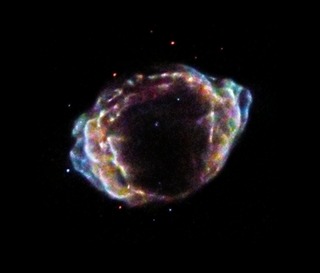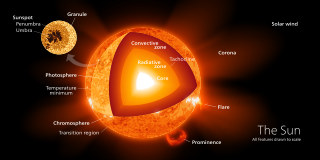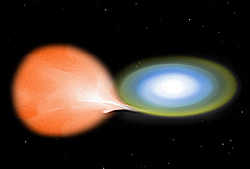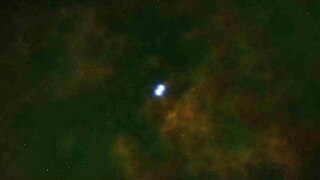The SuperNova Early Warning System (SNEWS) is a network of neutrino detectors designed to give early warning to astronomers in the event of a supernova in the Milky Way, our home galaxy, or in a nearby galaxy such as the Large Magellanic Cloud or the Canis Major Dwarf Galaxy.

A neutrino is a fermion that interacts only via the weak subatomic force and gravity. The neutrino is so named because it is electrically neutral and because its rest mass is so small (-ino) that it was long thought to be zero. The mass of the neutrino is much smaller than that of the other known elementary particles. The weak force has a very short range, the gravitational interaction is extremely weak, and neutrinos, as leptons, do not participate in the strong interaction. Thus, neutrinos typically pass through normal matter unimpeded and undetected.

A supernova is a powerful and luminous stellar explosion. A supernova is a transient astronomical event, occurring during the last evolutionary stages of a massive star or when a white dwarf is triggered into runaway nuclear fusion. The original star, called the progenitor, either collapses to a neutron star or black hole, or it is completely destroyed. The peak optical luminosity of a supernova can be comparable to that of an entire galaxy, before fading over several weeks or months.

The Milky Way is the galaxy that contains the Solar System, with the name describing the galaxy's appearance from Earth: a hazy band of light seen in the night sky formed from stars that cannot be individually distinguished by the naked eye. The term Milky Way is a translation of the Latin via lactea, from the Greek γαλαξίας κύκλος. From Earth, the Milky Way appears as a band because its disk-shaped structure is viewed from within. Galileo Galilei first resolved the band of light into individual stars with his telescope in 1610. Until the early 1920s, most astronomers thought that the Milky Way contained all the stars in the Universe. Following the 1920 Great Debate between the astronomers Harlow Shapley and Heber Curtis, observations by Edwin Hubble showed that the Milky Way is just one of many galaxies.
Contents
As of October 2018 [update] , SNEWS has not issued any supernova alerts. This is unsurprising because supernovae appear to be rare: the most recent known supernova remnant in the Milky Way was around the turn of the 20th century, and the most recent supernova confirmed to have been observed was Kepler's Supernova in 1604.

G1.9+0.3 is a supernova remnant (SNR) in the constellation of Sagittarius. It is the youngest known SNR in the Milky Way, resulting from an explosion which occurred some time between 1890 and 1908. The explosion was not seen from Earth as it was obscured by the dense gas and dust of the Galactic Center, where it occurred. The remnant's young age was established by combining data from NASA's Chandra X-ray Observatory and the VLA radio observatory. It was a type Ia supernova. The remnant has a radius of over 1.3 light years.

SN 1604, also known as Kepler's Supernova, Kepler's Nova or Kepler's Star, was a supernova of Type Ia that occurred in the Milky Way, in the constellation Ophiuchus. Appearing in 1604, it is the most recent supernova in our own galaxy to have been unquestionably observed by the naked eye, occurring no farther than 6 kiloparsecs or about 20,000 light-years from Earth.
Powerful bursts of electron neutrinos (νe) with typical energies of the order of 10 MeV and duration of the order of 10 seconds are produced in the core of a red giant star as it collapses on itself via the "neutronization" reaction, i.e. fusion of protons and electrons into neutrons: pe−→nνe. It is expected that the neutrinos are emitted well before the light from the supernova peaks, so in principle neutrino detectors could give advance warning to astronomers that a supernova has occurred and may soon be visible. The neutrino pulse from supernova 1987A arrived 3 hours before the associated photons – but SNEWS was not yet active and it was not recognised as a supernova event until after the photons arrived. However, SNEWS is not able to give advance warning of a type Ia supernova, as they are not expected to produce significant numbers of neutrinos. Type Ia supernovae, caused by a runaway nuclear fusion reaction in a white dwarf star, are thought to account for roughly one-third of all supernovae. [1]

The core of the Sun is considered to extend from the center to about 0.2 to 0.25 of solar radius. It is the hottest part of the Sun and of the Solar System. It has a density of 150 g/cm3 at the center, and a temperature of 15 million kelvins. The core is made of hot, dense plasma, at a pressure estimated at 265 billion bar at the center. Due to fusion, the composition of the solar plasma drops from 68–70% hydrogen by mass at the outer core, to 33% hydrogen at the core/Sun center.

A red giant is a luminous giant star of low or intermediate mass in a late phase of stellar evolution. The outer atmosphere is inflated and tenuous, making the radius large and the surface temperature around 5,000 K or lower. The appearance of the red giant is from yellow-orange to red, including the spectral types K and M, but also class S stars and most carbon stars.

SN 1987A was a type II supernova in the Large Magellanic Cloud, a dwarf galaxy satellite of the Milky Way. It occurred approximately 51.4 kiloparsecs from Earth and was the closest observed supernova since Kepler's Supernova, visible from earth in 1604. 1987A's light reached Earth on February 23, 1987, and as the earliest supernova discovered that year, was labeled "1987A". Its brightness peaked in May, with an apparent magnitude of about 3.
There are currently seven neutrino detector members of SNEWS: Borexino, Daya Bay, KamLAND, HALO, IceCube, LVD, and Super-Kamiokande. [2] SNEWS began operation prior to 2004, with three members (Super-Kamiokande, LVD, and SNO). The Sudbury Neutrino Observatory is no longer active as it is being upgraded to its successor program SNO+.

Borexino is a particle physics experiment to study low energy (sub-MeV) solar neutrinos.

The Daya Bay Reactor Neutrino Experiment is a China-based multinational particle physics project studying neutrinos. The multinational collaboration includes researchers from China, Chile, the United States, Taiwan, Russia, and the Czech Republic. The US side of the project is funded by the US Department of Energy's Office of High Energy Physics.
The Helium And Lead Observatory (HALO) is a neutrino detector at SNOLab for the Supernova Early Warning System (SNEWS). It began engineering operation on May 8, 2012, and joined as an operational part of SNEWS in October 2015.
The detectors send reports of a possible supernova to a computer at Brookhaven National Laboratory to identify a supernova. If the SNEWS computer identifies signals from two detectors within 10 seconds, the computer will send a supernova alert to observatories around the world to study the supernova. [3] The SNEWS mailing list is open-subscription, and the general public is allowed to sign up; however, the SNEWS collaboration encourages amateur astronomers to instead use Sky and Telescope magazine's AstroAlert service, which is linked to SNEWS.

Brookhaven National Laboratory (BNL) is a United States Department of Energy national laboratory located in Upton, New York, on Long Island, and was formally established in 1947 at the site of Camp Upton, a former U.S. Army base. Its name stems from its location within the Town of Brookhaven, approximately 60 miles east of New York City.









